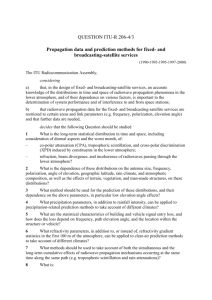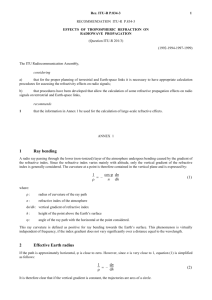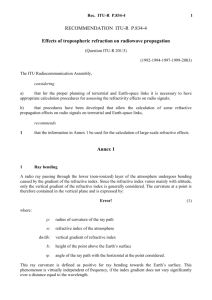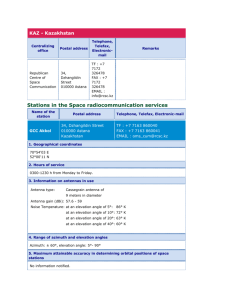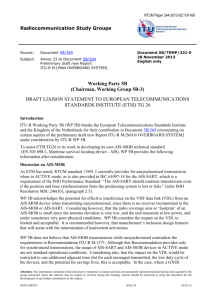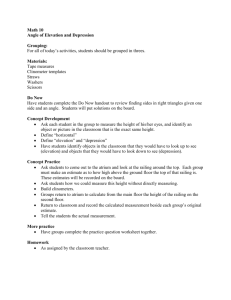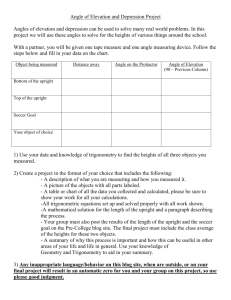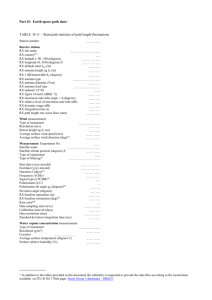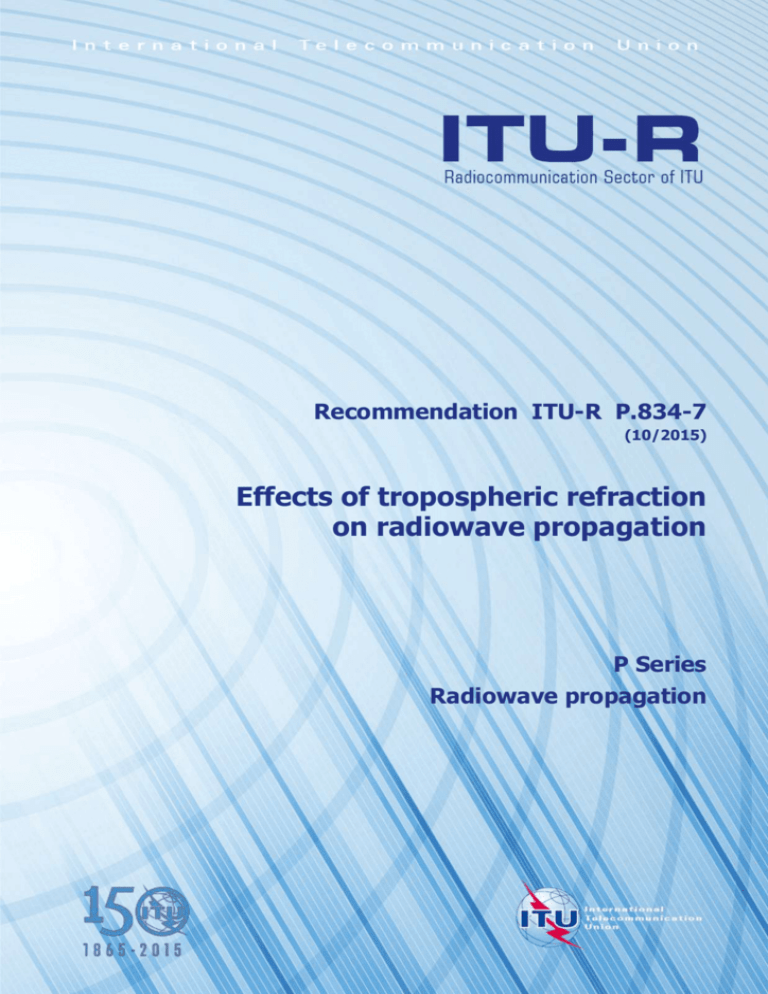
Recommendation ITU-R P.834-7
(10/2015)
Effects of tropospheric refraction
on radiowave propagation
P Series
Radiowave propagation
ii
Rec. ITU-R P.834-7
Foreword
The role of the Radiocommunication Sector is to ensure the rational, equitable, efficient and economical use of the
radio-frequency spectrum by all radiocommunication services, including satellite services, and carry out studies without
limit of frequency range on the basis of which Recommendations are adopted.
The regulatory and policy functions of the Radiocommunication Sector are performed by World and Regional
Radiocommunication Conferences and Radiocommunication Assemblies supported by Study Groups.
Policy on Intellectual Property Right (IPR)
ITU-R policy on IPR is described in the Common Patent Policy for ITU-T/ITU-R/ISO/IEC referenced in Annex 1 of
Resolution ITU-R 1. Forms to be used for the submission of patent statements and licensing declarations by patent
holders are available from http://www.itu.int/ITU-R/go/patents/en where the Guidelines for Implementation of the
Common Patent Policy for ITU-T/ITU-R/ISO/IEC and the ITU-R patent information database can also be found.
Series of ITU-R Recommendations
(Also available online at http://www.itu.int/publ/R-REC/en)
Series
BO
BR
BS
BT
F
M
P
RA
RS
S
SA
SF
SM
SNG
TF
V
Title
Satellite delivery
Recording for production, archival and play-out; film for television
Broadcasting service (sound)
Broadcasting service (television)
Fixed service
Mobile, radiodetermination, amateur and related satellite services
Radiowave propagation
Radio astronomy
Remote sensing systems
Fixed-satellite service
Space applications and meteorology
Frequency sharing and coordination between fixed-satellite and fixed service systems
Spectrum management
Satellite news gathering
Time signals and frequency standards emissions
Vocabulary and related subjects
Note: This ITU-R Recommendation was approved in English under the procedure detailed in Resolution ITU-R 1.
Electronic Publication
Geneva, 2015
ITU 2015
All rights reserved. No part of this publication may be reproduced, by any means whatsoever, without written permission of ITU.
Rec. ITU-R P.834-7
1
RECOMMENDATION ITU-R P.834-7
Effects of tropospheric refraction on radiowave propagation
(Question ITU-R 201/3)
(1992-1994-1997-1999-2003-2005-2007-2015)
Scope
Recommendation ITU-R P.834 provides methods for the calculation of large-scale refractive effects in
the atmosphere, including ray bending, ducting layers, the effective Earth radius, the apparent
elevation and boresight angles in Earth-space paths and the effective radio path length.
Keywords
Tropospheric excess path length, Earth-space link, GNSS, numerical weather product, digital maps
The ITU Radiocommunication Assembly,
considering
a)
that for the proper planning of terrestrial and Earth-space links it is necessary to have
appropriate calculation procedures for assessing the refractivity effects on radio signals;
b)
that procedures have been developed that allow the calculation of some refractive
propagation effects on radio signals on terrestrial and Earth-space links,
recommends
1
that the information in Annex 1 should be used for the calculation of large-scale refractive
effects.
Annex 1
1
Ray bending
A radio ray passing through the lower (non-ionized) layer of the atmosphere undergoes bending
caused by the gradient of the refractive index. Since the refractive index varies mainly with altitude,
only the vertical gradient of the refractive index is generally considered. The curvature at a point is
therefore contained in the vertical plane and is expressed by:
1
cos dn
n dh
where:
:
n:
dn/dh :
radius of curvature of the ray path
refractive index of the atmosphere
vertical gradient of refractive index
(1)
2
Rec. ITU-R P.834-7
h:
height of the point above the Earth’s surface
:
angle of the ray path with the horizontal at the point considered.
This ray curvature is defined as positive for ray bending towards the Earth’s surface. This
phenomenon is virtually independent of frequency, if the index gradient does not vary significantly
over a distance equal to the wavelength.
2
Effective Earth radius
If the path is approximately horizontal, is close to zero. However, since n is very close to 1,
equation (1) is simplified as follows:
1
dn
–
dh
(2)
It is therefore clear that if the vertical gradient is constant, the trajectories are arcs of a circle.
If the height profile of refractivity is linear, i.e. the refractivity gradient is constant along the ray
path, a transformation is possible that allows propagation to be considered as rectilinear. The
transformation is to consider a hypothetical Earth of effective radius Re k a, with:
1
1
dn
1
ka
a
dh
Re
(3)
where a is the actual Earth radius, and k is the effective earth radius factor (k-factor). With this
geometrical transformation, ray trajectories are linear, irrespective of the elevation angle.
Strictly speaking, the refractivity gradient is only constant if the path is horizontal. In practice, for
heights below 1 000 m the exponential model for the average refractive index profile (see
Recommendation ITU-R P.453) can be approximated by a linear one. The corresponding k-factor is
k 4/3.
3
Modified refractive index
For some applications, for example for ray tracing, a modified refractive index or refractive
modulus is used, defined in Recommendation ITU-R P.310. The refractive modulus M is given by:
M N
h
a
(4)
h being the height of the point considered expressed in metres and a the Earth’s radius expressed in
thousands of kilometres. This transformation makes it possible to refer to propagation over a flat
Earth surmounted by an atmosphere whose refractivity would be equal to the refractive modulus M.
4
Apparent boresight angle on slant paths
4.1
Introduction
In sharing studies it is necessary to estimate the apparent elevation angle of a space station taking
account of atmospheric refraction. An appropriate calculation method is given below.
Rec. ITU-R P.834-7
4.2
3
Visibility of space station
As described in § 1 above, a radio beam emitted from a station on the Earth’s surface (h (km)
altitude and (degrees) elevation angle) would be bent towards the Earth due to the effect of
atmospheric refraction. The refraction correction, (degrees), can be evaluated by the following
integral:
h
n' x
dx
nx tan
where is determined as follows on the basis of Snell’s law in polar coordinates:
c
cos
(r x) n( x)
c (r h) n(h) cos
r:
x:
(5)
(6)
(7)
Earth’s radius (6 370 km)
altitude (km).
Since the ray bending is very largely determined by the lower part of the atmosphere, for a typical
atmosphere the refractive index at altitude x may be obtained from:
n( x) 1 a exp ( bx)
(8)
where:
a 0.000315
b 0.1361.
This model is based on the exponential atmosphere for terrestrial propagation given in Recommendation ITU-R P.453. In addition, n' (x) is the derivative of n(x), i.e. n' (x) –ab exp (–bx).
The values of (h, ) (degrees) have been evaluated under the condition of the reference
atmosphere and it was found that the following numerical formula gives a good approximation:
(h, ) 1/[1.314 0.6437 0.02869 2 h (0.2305 0.09428 0.01096 2) 0.008583 h2]
(9)
The above formula has been derived as an approximation for 0 h 3 km and m 10, where
m is the angle at which the radio beam is just intercepted by the surface of the Earth and is given
by:
r
n(0)
m arc cos
r h n(h)
(10)
or, approximately, m 0.875 h (degrees).
Equation (9) also gives a reasonable approximation for 10 90.
Let the elevation angle of a space station be 0 (degrees) under free-space propagation conditions,
and let the minimum elevation angle from a station on the Earth’s surface for which the radio beam
is not intercepted by the surface of the Earth be m. The refraction correction corresponding to m is
(h, m). Therefore, the space station is visible only when the following inequality holds:
m (h, m ) 0
4.3
(11)
Estimation of the apparent elevation angle
When the inequality in equation (11) holds, the apparent elevation angle, (degrees), can be
calculated, taking account of atmospheric refraction, by solving the following equation:
4
Rec. ITU-R P.834-7
h, 0
(12)
and the solution of equation (12) is given as follows:
0 s h, 0
(13)
where the values of s (h, 0) are identical with those of (h, ), but are expressed as a function
of 0.
The function s (h, 0) (degrees) can be closely approximated by the following numerical formula:
s (h, 0) 1/[1.728 0.5411 0 0.03723 02 h (0.1815 0.06272 0
0.01380 02) h2 (0.01727 0.008288 0)]
(14)
The value of calculated by equation (13) is the apparent elevation angle.
4.4
Summary of calculations
Step 1: The elevation angle of a space station in free-space propagation conditions is designated
as 0.
Step 2: By using equations (9) and (10), examine whether equation (11) holds or not. If the answer
is no, the satellite is not visible and, therefore, no further calculations are required.
Step 3: If the answer in Step 2 is yes, calculate by using equations (13) and (14).
4.5
Measured results of apparent boresight angle
Table 1 presents the average angular deviation values for propagation through the total atmosphere.
It summarizes experimental data obtained by radar techniques, with a radiometer and a
radiotelescope. There are fluctuations about the apparent elevation angle due to local variations in
the refractive index structure.
TABLE 1
Angular deviation values for propagation through the total atmosphere
Elevation angle,
(degrees)
1
2
4
10
20
30
1
10
Average total angular deviation,
(degrees)
Polar
continental air
Temperate
continental air
Temperate
maritime air
Tropical
maritime air
0.45
0.32
0.21
0.10
–
0.36
0.25
0.11
0.05
0.03
–
0.38
0.26
0.12
0.06
0.04
0.65
0.47
0.27
0.14
Day-to-day variation in (for columns 1 and 4 only)
0.1
r.m.s.
0.007 r.m.s.
Rec. ITU-R P.834-7
5
5
Focusing and defocusing of a wave for propagation through the atmosphere
Changes in signal level may also result from spreading or narrowing of the antenna beam caused by
the variation of atmospheric refraction with the elevation angle. This effect should be negligible for
elevation angles above 3°.
The equation below can be used to calculate the signal loss or gain due to refraction effects for a
wave passing through the total atmosphere
b 10 log( B )
where:
B 1
1.728 0.5411
0:
h:
b:
6
0.5411 0.074460 h0.06272 0.02760 h 2 0.08288
0
0.0372302 h(0.1815 0.062720 0.013802 ) h 2 (0.01727 0.0082880 )
elevation angle of the line connecting the transmitting and receiving points,
(degrees) (0 < 10°)
altitude of the lower point above sea level, (km) (h < 3 km)
change in signal level for the wave passing through the atmosphere, compared
to free-space conditions, (dB)
the sign in the equation for b will be negative “−” for a transmitting source
located near the Earth’s surface and positive “+” for a source located outside
the atmosphere.
Excess radio path length and its variations
Since the tropospheric refractive index is higher than unity and varies as a function of altitude, a
wave propagating between the ground and a satellite has a radio path length exceeding the
geometrical path length. The difference in length can be obtained by the following integral:
B
L (n 1) ds
(15)
A
where:
s:
n:
A and B :
length along the path
refractive index
path ends.
Equation (15) can be used only if the variation of the refractive index n along the path is known.
When the temperature T, the atmospheric pressure P and the relative humidity H are known at the
ground level, the excess path length L can be computed using the semi-empirical method
explained below, which has been derived using the atmospheric radio-sounding profiles provided
by a one-year campaign at 500 meteorological stations in 1979. In this method, the general
expression of the excess path length L is:
L
LV
sin 0 (1 k cot 2 0 )1/ 2
(0 , LV )
where:
0 :
elevation angle at the observation point
(16)
2
6
Rec. ITU-R P.834-7
LV :
k and (0, LV) :
vertical excess path length
corrective terms, in the calculation of which the exponential atmosphere model
is used.
The k factor takes into account the variation of the elevation angle along the path. The (0, LV)
term expresses the effects of refraction (the path is not a straight line). This term is always very
small, except at very low elevation angle and is neglected in the computation; it involves an error of
only 3.5 cm for a 0 angle of 10 and of 0.1 mm for a 0 angle of 45. It can be noted, moreover,
that at very low elevation for which the term would not be negligible, the assumption of a plane
stratified atmosphere, which is the basis of all methods of computation of the excess path length, is
no longer valid.
The vertical excess path length (m) is given by:
LV 0.00227 P f (T ) H
(17)
In the first term of the right-hand side of equation (17), P is the atmospheric pressure (hPa) at the
observation point.
In the empirical second term, H is the relative humidity (%); the function of temperature f (T )
depends on the geographical location and is given by:
f (T ) a 10bT
(18)
where:
T
a
is in C
is in m/% of relative humidity
b
is in C–1.
Parameters a and b are given in Table 2 according to the geographical location.
TABLE 2
a
(m/%)
b
(C–1)
Coastal areas (islands, or locations less than 10 km
away from sea shore)
5.5 10−4
2.91 10−2
Non-coastal equatorial areas
6.5 10−4
2.73 10−2
All other areas
7.3 10−4
2.35 10−2
Location
To compute the corrective factor k of equation (16), an exponential variation with height h of the
atmospheric refractivity N is assumed:
N(h) Ns exp (– h / h0)
(19)
where Ns is the average value of refractivity at the Earth surface (see Recommendation
ITU-R P.453) and h0 is given by:
h0 106
k is then computed from the following expression:
LV
Ns
(20)
Rec. ITU-R P.834-7
ns rs
k 1
n (h0 ) r (ho )
7
2
(21)
where ns and n (h0) are the values of the refractive index at the Earth surface and at height h0 (given
by equation (20)) respectively, and rs and r (h0) are the corresponding distances to the centre of the
Earth.
For Earth-space paths with elevation angles, the tropospheric excess path length, L(), (m) can
be expressed as the sum of hydrostatic and wet components, LH() and LW().
The excess path length along a vertical path, LHv and LWv can be projected to the elevation angle,
, greater than 3°, using two separate mapping function for the hydrostatic and wet components,
mH() and mW():
LLH LW LHv mH LWv mW
m
(22)
The hydrostatic vertical component at the Earth surface, LHvs, can be derived using:
LHvs 10 6
Rd
k1 ps
g ms
m
(22a)
The wet vertical component at the Earth surface, LWvs, can be derived using:
R
k2 es
LWvs 106 d
g ms ( 1) Tms
m
(22b)
where:
ps, es:
Tms:
λ:
Rd :
R:
Md:
k1 =
k2 =
gms=
gm(h) =
=
lat:
hs:
air total pressure and water vapour partial pressure at the Earth surface (hPa)
mean temperature of the water vapour column above the surface (K)
vapour pressure decrease factor
R/Md = 287.0 (J/kg K)
molar gas constant = 8.314 (J/mol K)
dry air molar mass = 28.9644 (g/mol)
77.604 (K/hPa)
373 900 (K2/hPa)
gm(hs)
9.784 (1 – 0.00266 cos (2 lat) – 0.00028 h)
gravity acceleration at the mass centre of air from height h (m/s2)
Latitude of the location (radians)
height of the Earth surface above mean sea level (a.m.s.l., km).
For receivers located at a height, h (km), different than the surface height, hs, the hydrostatic and
wet vertical component, LHv(h) and LWv(h), are given by:
LHv h 10 6
LWv h 10 6
Rd
k1 ph
g m ( h)
Rd
k2
eh
g m (h) ( 1) Tm h
m
(23a)
m
(23b)
8
Rec. ITU-R P.834-7
where:
The values of the input meteorological parameters at height h, Tm(h), e(h) and p(h), can be derived
from values at the Earth surface, Tms, es and ps, using the following equations:
Tm (h) Tms m (h hs )
K
(24a)
hPa
(24b)
g
(hhs ) Rd
p(h) ps 1
Ts
p ( h)
e(h) es
ps
1
hPa
(24c)
where:
m:
lapse rate of the mean temperature of water vapour from the Earth surface
(K/km)
Ts =
Rd
air temperature at Earth surface (K) = Tms 1
(1) g
=
lapse
rate
of
(K/km) 0.5 1 g
Rd =
g=
Rd /1000 = 0.287
Rd
air
1 g 1 g 4
Rd
Rd
temperature
m
J/(g K)
gravity
acceleration
at
Earth
9.806 1 0.002637 cos2 lat 0.00031 hs
surface
[m/s2]
=
All the input parameters of the model, ps, es, Tms, , and m, can be derived by assuming the
meteorological parameters are characterized by the seasonal fluctuation:
( D y a3i )
X i ( D y ) a1i a 2i cos 2
365.25
(25)
where:
Xi:
a1i:
a2i:
a3i:
Dy:
ps, es, Tms, or m. Index i, 1 designates ps, 2 designates es, 3 designates Tms,
4 designates , 5 designates m
average value of the parameter
seasonal fluctuation of the parameter
day of the minimum value of the parameter
day of the year (1, 2, ... , 365.25), 1 = 1 January, 32 = 1 February,
60.25 = 1 March.
The coefficients a1, a2 and a3 of the parameters ps, es, Tms, , and m, and the height of the
reference level, href, at which these coefficients have been calculated, are an integral part of this
Recommendation and are available in the form of digital maps provided in the file R-RECP.834-7201504-I!!ZIP-E.
Rec. ITU-R P.834-7
9
The data is from 0° to 360° in longitude and from +90° to −90° in latitude, with a resolution of 1.5°
in both latitude and longitude. The excess path length at any desired location and at any height
above the surface, h, can be derived by the following method:
a)
Determine the coefficients a1i, a2i and a3i, of the five parameters, ps, es, Tms, , m, and the
reference height, href, from the maps at the four grid points closest to the desired location.
b)
Calculate the values of the five parameters, ps, es, Tms, or m, at the reference height, href,
'
'
'
'
for the day of the year Dy, Xi1 , Xi 2 , Xi3 and Xi 4 at the four closest grid points, using
equation (25) with the coefficients a1i, a2i and a3i of each grid point.
c)
Calculate the value of the three parameters, p(h), e(h) and Tm(h), at the height h at the four
'
'
'
closest grid points using equations (24a), (24b) and (24c) with the values of Xi1 , Xi 2 , Xi3
and Xi 4 , and with the values of href of each grid point.
'
d)
Calculate the values of LHv(h) and LWv(h), at the height h at the four grid points closest to
the desired location, using equations (23a) and (23b) with the values of p(h), e(h) and Tm(h)
of each grid point.
e)
Calculate the values at height h of LHv(h) and LWv(h), at the desired location by
performing a bi-linear interpolation of the four values of LHv(h) and LWv(h) at the four
grid points as described in Recommendation ITU-R P.1144.
Calculate the value of tropospheric excess path length at the height h at the desired location,
L(h,), using equation (22).
f)
The accuracy of the proposed model has been tested using radiosonde, GNSS and radiometric
measurements to determine Lvs and the worldwide uncertainty is between 2 and 6 cm. Where a
higher accuracy is needed, concurrent local measurements of air total pressure and water vapour
pressure can be used as inputs to the model.
The mapping function of the hydrostatic and wet components, mh() and mw() are given by:
mh m, ah , bh , ch
(26a)
mw m, aw , bw , cw
(26b)
where:
a
1
1 b
1 c
m()
a
sin
sin b
sin c
bh = 0.0029
bw = 0.00146
cw = 0.04391
10
Rec. ITU-R P.834-7
D y 28
ch c1 cos
2 1 c11 c10 1 coslat
365.25
c1
c10
c11
ψ
Northern
0.062
0.001
0.005
0
Southern
0.062
0.002
0.007
π
Hemisphere
(26c)
Dy
Dy
Dy
Dy
B1h sin 2
A2h cos 4
B2h sin 4
ah A0h A1h cos 2
365.25
365.25
365.25
365.25
(26d)
Dy
Dy
Dy
Dy
B1w sin 2
A2 w cos 4
B2 w sin 4
aw A0 w A1w cos 2
365.25
365.25
365.25
365.25
(26e)
The coefficients A0h, A1h, A2h, B1h, B2h, A0w, A1w, A2w, B1w and B2w are an integral part of this
Recommendation and are available in the form of digital maps in the file R-RECP.834-7-201504I!!ZIP-E.ZIP. Calculate the values of the parameters ah and aw at the desired location by performing
a bi-linear interpolation of the four values of these coefficients at the four grid points as described in
Recommendation ITU-R P.1144.
For the case of an Earth-space link with elevation angles, , greater than 20°, the mapping functions
given by equations (26a) and (26b) can be approximated by:
mh mw
1
sin
(26f)
In the application of this model it is recommended to use either equations (26a) and (26b) or
equation (26f) consistently along all the elevation angles.
Rec. ITU-R P.834-7
11
FIGURE 1
Maps of the average excess path delay at reference level in January and July
15 January
90
75
60
Latitude (degrees)
45
30
15
0
–15
Excess
path
length
(m)
–30
–45
–60
–75
–90
–180 –165 –150 –135 –120 –105 –90 –75 –60 –45 –30 –15
0
15
30
45
60
75
90
105 120 135 150 165 180
45
60
75
90
105 120 135 150 165 180
Longitude (degrees )
15 July
90
Latitude (degree s)
75
60
45
30
15
2.5
2.4
2.3
2.2
2.1
2.0
1.9
1.8
1.7
1.6
1.5
1.4
1.3
1.2
0
–15
–30
–45
–60
–75
–90
–180 –165 –150 –135 –120 –105 –90 –75 –60 –45 –30 –15
0
15
30
Longitude (degrees )
P.0834-01
7
Propagation in ducting layers
Ducts exist whenever the vertical refractivity gradient at a given height and location is less than
−157 N/km.
The existence of ducts is important because they can give rise to anomalous radiowave propagation,
particularly on terrestrial or very low angle Earth-space links. Ducts provide a mechanism for
radiowave signals of sufficiently high frequencies to propagate far beyond their normal line-of-sight
range, giving rise to potential interference with other services (see Recommendation ITU-R P.452).
They also play an important role in the occurrence of multipath interference (see Recommendation
ITU-R P.530) although they are neither necessary nor sufficient for multipath propagation to occur
on any particular link.
7.1
Influence of elevation angle
When a transmitting antenna is situated within a horizontally stratified radio duct, rays that are
launched at very shallow elevation angles can become “trapped” within the boundaries of the duct.
For the simplified case of a “normal” refractivity profile above a surface duct having a fixed
refractivity gradient, the critical elevation angle (rad) for rays to be trapped is given by the
expression:
12
Rec. ITU-R P.834-7
2 106
dM
h
dh
(27)
dM
0 and h is the thickness of
where dM/dh is the vertical gradient of modified refractivity
d
h
the duct which is the height of duct top above transmitter antenna.
Figure 2 gives the maximum angle of elevation for rays to be trapped within the duct. The
maximum trapping angle increases rapidly for decreasing refractivity gradients below −157 N/km
(i.e. increasing lapse rates) and for increasing duct thickness.
7.2
Minimum trapping frequency
The existence of a duct, even if suitably situated, does not necessarily imply that energy will be
efficiently coupled into the duct in such a way that long-range propagation will occur. In addition to
satisfying the maximum elevation angle condition above, the frequency of the wave must be above
a critical value determined by the physical depth of the duct and by the refractivity profile. Below
this minimum trapping frequency, ever-increasing amounts of energy will leak through the duct
boundaries.
The minimum frequency for a wave to be trapped within a tropospheric duct can be estimated using
a phase integral approach. Figure 3 shows the minimum trapping frequency for surface ducts (solid
curves) where a constant (negative) refractivity gradient is assumed to extend from the surface to a
given height, with a standard profile above this height. For the frequencies used in terrestrial
systems (typically 8-16 GHz), a ducting layer of about 5 to 15 m minimum thickness is required and
in these instances the minimum trapping frequency, fmin, is a strong function of both the duct
thickness and the refractive index gradient.
In the case of elevated ducts an additional parameter is involved even for the simple case of a linear
refractivity profile. That parameter relates to the shape of the refractive index profile lying below
the ducting gradient. The dashed curves in Fig. 3 show the minimum trapping frequency for a
constant gradient ducting layer lying above a surface layer having a standard refractivity gradient of
−40 N/km.
Rec. ITU-R P.834-7
13
FIGURE 2
Maximum trapping angle for a surface duct of constant
refractivity gradient over a spherical Earth
5.0
0.25
4.0
0.20
50 m
3.0
20 m
0.15
10 m
2.0
0.10
1.0
0.0
– 100
Critical trapping angle (degrees)
Critical trapping angle (mrad)
Duct thickness = 100 m
0.05
– 200
– 300
0.00
– 400
Refractivity gradient (N/km)
P.0834-02
For layers having lapse rates that are only slightly greater than the minimum required for ducting to
occur, the minimum trapping frequency is actually increased over the equivalent surface-duct case.
For very intense ducting gradients, however, trapping by an elevated duct requires a much thinner
layer than a surface duct of equal gradient for any given frequency.
14
Rec. ITU-R P.834-7
FIGURE 3
Minimum frequency for trapping in atmospheric radio ducts
of constant refractivity gradients
25
–600 N/km
20
Minimum trapping frequency (GHz)
–400 N/km
–300 N/km
15
–250 N/km
10
–200 N/km
5
0
0
10
20
30
40
Layer thickness (m)
Surface-based ducts
Elevated ducts above standard refractive profile
P.0834-03

